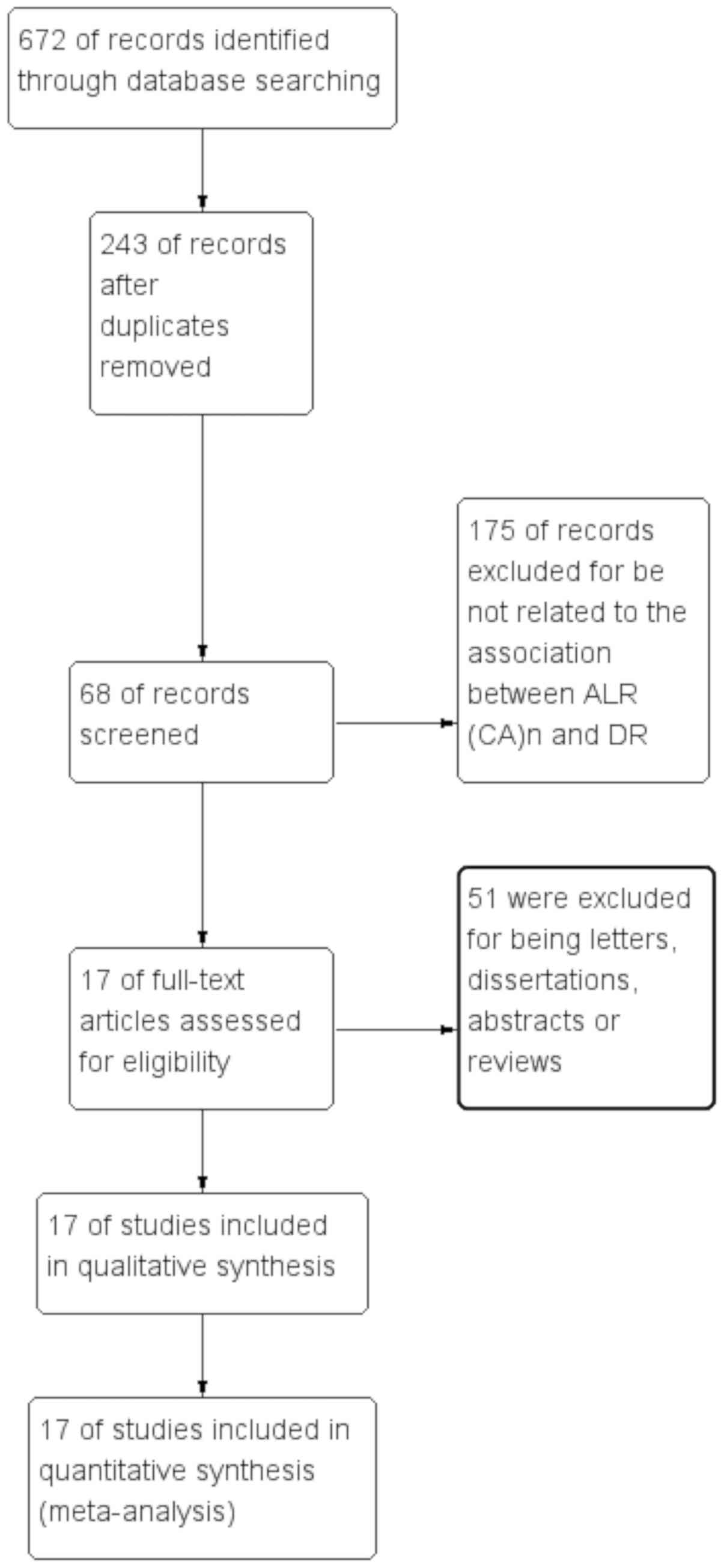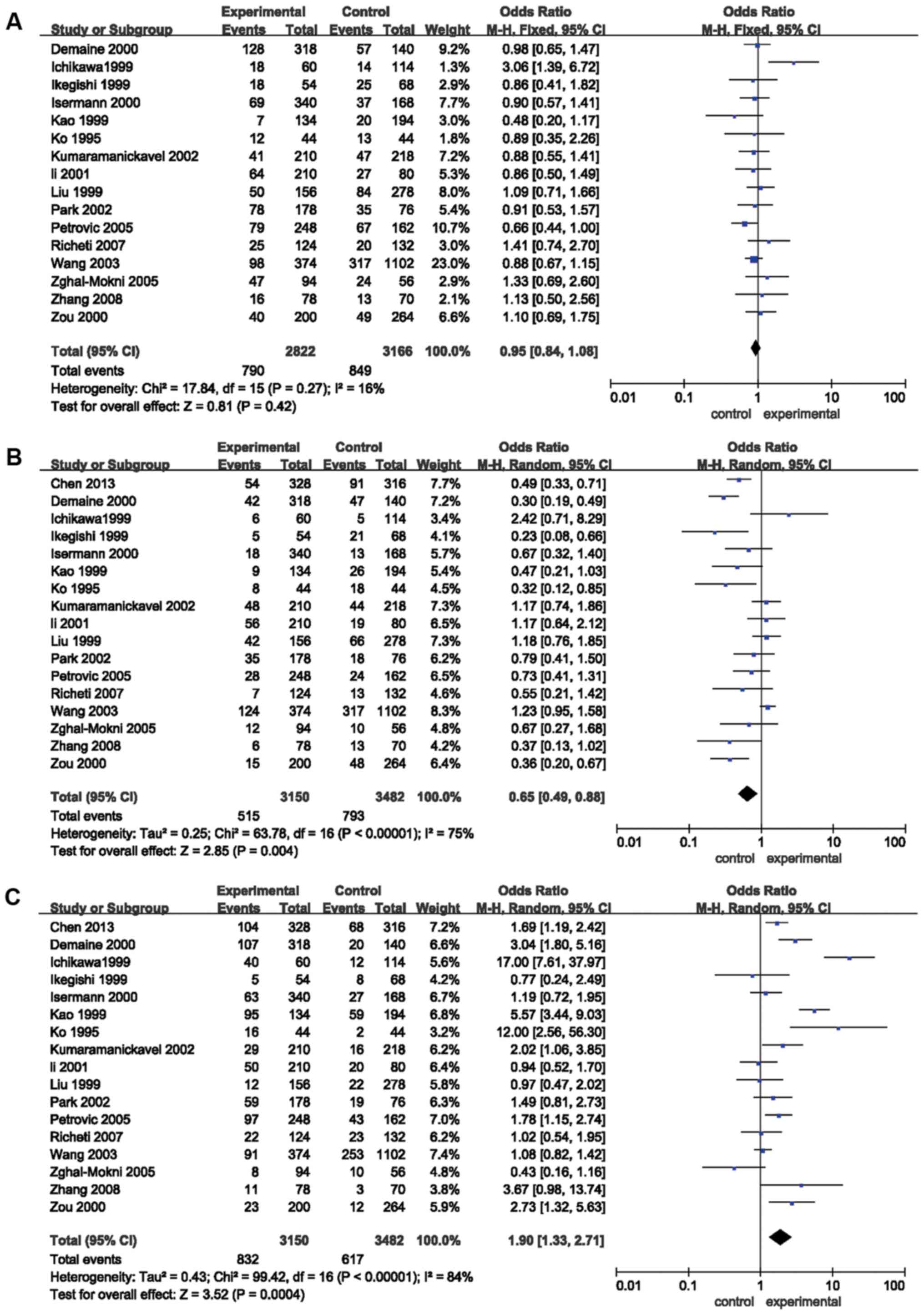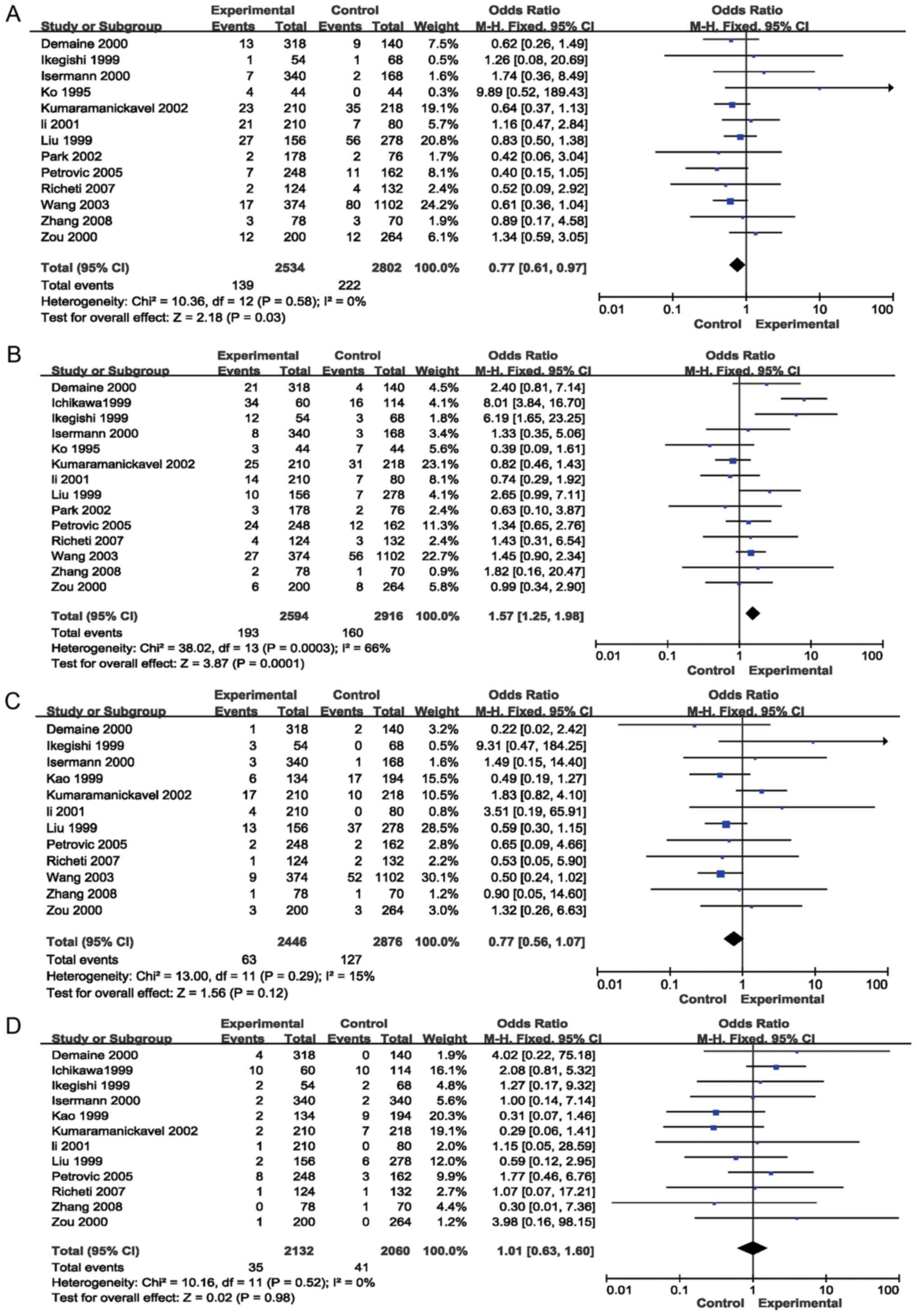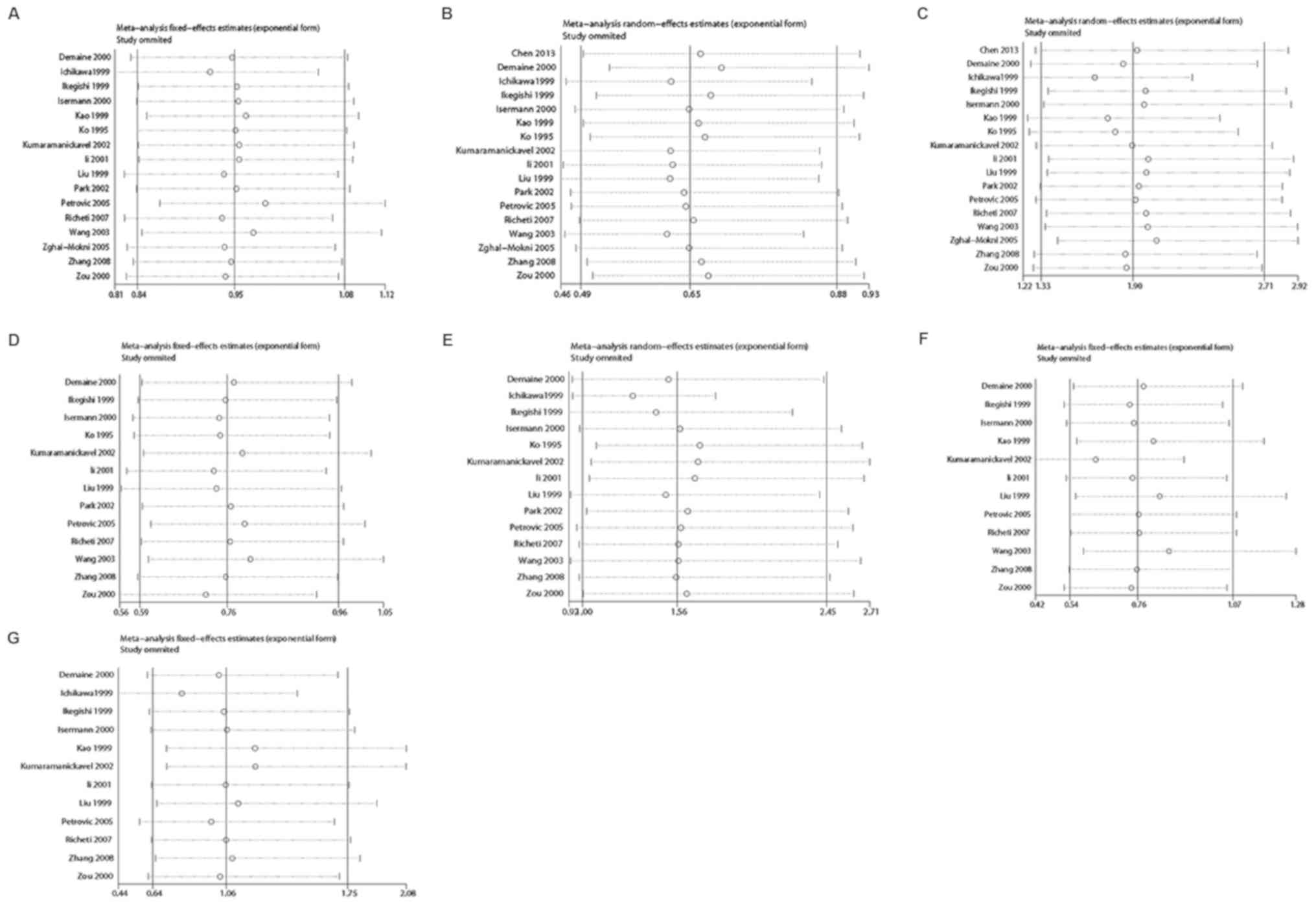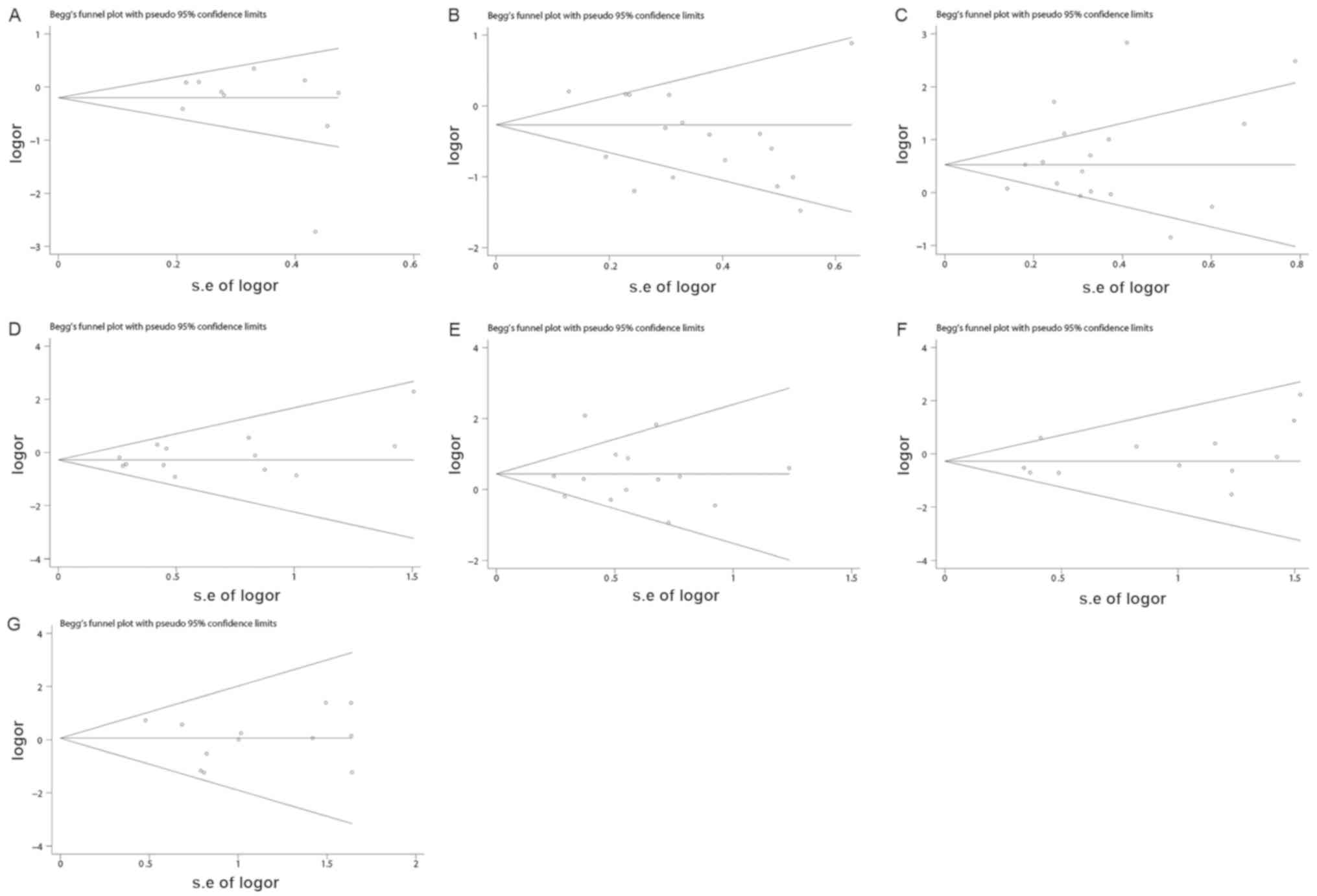|
1
|
Ola MS, Nawaz MI, Siddiquei MM, Al-Amro S
and Abu El-Asrar AM: Recent advances in understanding the
biochemical and molecular mechanism of diabetic retinopathy. J
Diabetes Complications. 26:56–64. 2012. View Article : Google Scholar : PubMed/NCBI
|
|
2
|
Chang YC and Wu WC: Dyslipidemia and
diabetic retinopathy. Rev Diabet Stud. 10:121–132. 2012. View Article : Google Scholar
|
|
3
|
Tuuminen R, Haukka J and Loukovaara S:
Poor glycemic control associates with high intravitreal
angiopoietin-2 levels in patients with diabetic retinopathy. Acta
Ophthalmologica. 93:e515–e516. 2015. View Article : Google Scholar : PubMed/NCBI
|
|
4
|
Grassi MA, Tikhomirov A, Ramalingam S,
Below JE, Cox NJ and Nicolae DL: Genome-wide meta-analysis for
severe diabetic retinopathy. Hum Mol Genet. 20:2472–2481. 2011.
View Article : Google Scholar : PubMed/NCBI
|
|
5
|
Warpeha KM and Chakravarthy U: Molecular
genetics of microvascular disease in diabetic retinopathy. Eye
(Lond). 17:305–311. 2003. View Article : Google Scholar : PubMed/NCBI
|
|
6
|
Gonzalez-Salinas R, Garcia-Gutierrez MC,
Garcia-Aguirre G, Morales-Canton V, Velez-Montoya R,
Soberon-Ventura VR, Gonzalez V, Lechuga R, Garcia-Solis P,
Garcia-Gutierrez DG, et al: Evaluation of VEGF gene polymorphisms
and proliferative diabetic retinopathy in Mexican population. Int J
Ophthalmol. 10:135–139. 2017.PubMed/NCBI
|
|
7
|
Wang W, He M and Huang W: Association of
monocyte chemoattractant protein-1 gene 2518A/G polymorphism with
diabetic retinopathy in type 2 diabetes mellitus: A meta-analysis.
Diabetes Res Clin Pract. 120:40–46. 2016. View Article : Google Scholar : PubMed/NCBI
|
|
8
|
Zhang Y, Xia W, Lu P and Yuan HJ: The
association between VDR gene polymorphisms and diabetic retinopathy
susceptibility: A systematic review and meta-analysis. Biomed Res
Int. 2016:53052822016. View Article : Google Scholar : PubMed/NCBI
|
|
9
|
Li GY, Li ZB, Li F, Dong LP, Tang L, Xiang
J, Li JM and Bao MH: Meta-analysis on the association of ALDH2
polymorphisms and type 2 diabetic mellitus, diabetic retinopathy.
Int J Environ Res Public Health. 14(pii): E1652017. View Article : Google Scholar : PubMed/NCBI
|
|
10
|
Fujisawa T, Ikegami H, Kawaguchi Y,
Shintani M, Kawabata Y, Ono M, Nishino M, Ogihara T, Okamoto N and
Fukuda M: Genetic susceptibility to diabetic retinopathy: CA repeat
polymorphism of the aldose reductase gene. Folia Jap Ophthalmol
Clin. 52:128–130. 2001.
|
|
11
|
Abhary S, Burdon KP, Laurie KJ, Thorpe S,
Landers J, Goold L, Lake S, Petrovsky N and Craig JE: Aldose
reductase gene polymorphisms and diabetic retinopathy
susceptibility. Diabetes Care. 33:1834–1836. 2010. View Article : Google Scholar : PubMed/NCBI
|
|
12
|
Crespo I, Giménez-Dejoz J, Porté S,
Cousido-Siah A, Mitschler A, Podjarny A, Pratsinis H, Kletsas D,
Parés X, Ruiz FX, et al: Design, synthesis, structure-activity
relationships and X-ray structural studies of novel
1-oxopyrimido[4,5-c]quinoline-2-acetic acid derivatives as
selective and potent inhibitors of human aldose reductase. Eur J
Med Chem. 152:160–174. 2018. View Article : Google Scholar : PubMed/NCBI
|
|
13
|
Radha V, Rema M and Mohan V: Genes and
diabetic retinopathy. Indian J Ophthalmol. 50:5–11. 2002.PubMed/NCBI
|
|
14
|
Graham A, Brown L, Hedge PJ, Gammack AJ
and Markham AF: Structure of the human aldose reductase gene. J
Biol Chem. 266:6872–6877. 1991.PubMed/NCBI
|
|
15
|
Li YY, Wang H, Yang XX, Geng HY, Gong G
and Lu XZ: AR C-106T gene polymorphism and diabetic nephropathy in
the Eastern Asians with T2DM: A meta-analysis including 2120
subjects. Diabetes Res Clin Pract. 130:244–251. 2017. View Article : Google Scholar : PubMed/NCBI
|
|
16
|
Gupta B and Singh SK: Association of
aldose reductase gene polymorphism (C-106T) in susceptibility of
diabetic peripheral neuropathy among north Indian population. J
Diabetes Complications. 31:1085–1089. 2017. View Article : Google Scholar : PubMed/NCBI
|
|
17
|
Abhary S, Hewitt AW, Burdon KP and Craig
JE: A systematic meta-analysis of genetic association studies for
diabetic retinopathy. Diabetes. 58:2137–2147. 2009. View Article : Google Scholar : PubMed/NCBI
|
|
18
|
Olmos P, Bastías MJ, Vollrath V, Toro L,
Trincado A, Salinas P, Claro JC, López JM, Acosta AM, Miquel JF and
Castro J: C(−106)T polymorphism of the aldose reductase gene and
the progression rate of diabetic retinopathy. Diabetes Res Clin
Pract. 74:175–182. 2006. View Article : Google Scholar : PubMed/NCBI
|
|
19
|
Zhou M, Zhang P, Xu X and Sun Z: The
relationship between aldose reductase C106T polymorphism and
diabetic retinopathy: An updated meta-analysis. Invest Ophthalmol
Vis Sci. 56:2279–2289. 2015. View Article : Google Scholar : PubMed/NCBI
|
|
20
|
Song ZD, Tao Y, Han N and Wu YZ:
Association of the aldose reductase-106TT genotype with increased
risk for diabetic retinopathy in the Chinese han population: An
updated meta-analysis. Curr Eye Res. 41:1087–1091. 2015. View Article : Google Scholar : PubMed/NCBI
|
|
21
|
Ng DP, Conn J, Chung SS and Larkins RG:
Aldose reductase (AC)n microsatellite polymorphism and diabetic
microvascular complications in Caucasian Type 1 diabtes mellitus.
Diabetes Res Clin Pract. 52:21–27. 2001. View Article : Google Scholar : PubMed/NCBI
|
|
22
|
dos Santos KG, Canani LH, Gross JL,
Tschiedel B, Souto KE and Roisenberg I: The-106CC genotype of the
aldose reductase gene is associated with an increased risk of
proliferative diabetic retinopathy in Caucasian-Brazilians with
type 2 diabetes. Mol Genet Metab. 88:280–284. 2006. View Article : Google Scholar : PubMed/NCBI
|
|
23
|
Heesom AE, Hibberd ML, Millward A and
Demaine AG: Polymorphism in the 5′-end of the aldose reductase gene
is strongly associated with the development of diabetic nephropathy
in type I diabetes. Diabetes. 46:287–291. 1997. View Article : Google Scholar : PubMed/NCBI
|
|
24
|
Kao YL, Donaghue K, Chan A, Knight J and
Silink M: An aldose reductase intragenic polymorphism associated
with diabetic retinopathy. Diabetes Res Clin Pract. 46:155–160.
1999. View Article : Google Scholar : PubMed/NCBI
|
|
25
|
Liu L, Xiang K and Zheng T: A study of
association between polymorphism of aldose reductase gene and
diabetic microangiopathy. Chin J Endocrinol Metab. 15:263–266.
1999.
|
|
26
|
Zghal-Mokni I, Arfa I, Elloumi-Zghal H,
Abid A, Amrouche-Rached C, Kaabi B, Chakroun S, Blousa-Chabchoub S,
Gaïgi S, Ayed S, et al: Association study between diabetic
retinopathy and aldose reductase gene polymorphism in Tunisians. J
Fr Ophtalmol. 28:386–390. 2005.(In French). View Article : Google Scholar : PubMed/NCBI
|
|
27
|
Richeti F, Noronha RM, Waetge RT, de
Vasconcellos JP, de Souza OF, Kneipp B, Assis N, Rocha MN, Calliari
LE, Longui CA, et al: Evaluation of AC(n) and C(−106)T
polymorphisms of the aldose reductase gene in Brazilian patients
with DM1 and susceptibility to diabetic retinopathy. Mol Vis.
13:740–745. 2007.PubMed/NCBI
|
|
28
|
Park HK, Ahn CW, Lee GT, Kim SJ, Song YD,
Lim SK, Kim KR, Huh KB and Lee HC: (AC)(n) polymorphism of aldose
reductase gene and diabetic microvascular complications in type 2
diabetes mellitus. Diabetes Res Clin Pract. 55:151–157. 2002.
View Article : Google Scholar : PubMed/NCBI
|
|
29
|
Ko BC, Lam KS, Wat NM and Chung SS: An
(A-C)n dinucleotide repeat polymorphic marker at the 5′ end of the
aldose reductase gene is associated with early-onset diabetic
retinopathy in NIDDM patients. Diabetes. 44:727–732. 1995.
View Article : Google Scholar : PubMed/NCBI
|
|
30
|
Petrovic MG, Peterlin B, Hawlina M and
Petrovic D: Aldose reductase (AC)n gene polymorphism and
susceptibility to diabetic retinopathy in type 2 diabetes in
Caucasians. J Diabetes Complications. 19:70–73. 2005. View Article : Google Scholar : PubMed/NCBI
|
|
31
|
Higgins J and Green S: Cochrane handbook
for systematic reviews of interventions, version 5.1.0 [updated
March 2011]The Cochrane Collaboration. 2011
|
|
32
|
Boccia S: PRISMA: An attempt to improve
standards for reporting systematic review and meta-analysis.
Epidemiol Biostatist Public Health. 6:E3822009.
|
|
33
|
Wells GA, Shea BJ, O'Connell D, Robertson
J, Peterson J, Welch V, Losos M and Tugwell P: The newcastle-ottawa
scale (NOS) for assessing the quality of nonrandomized studies in
meta-analysis. Appl Eng Agric. 18:727–734. 2014.
|
|
34
|
Li QJ, Xie P, Zeng WM and Song HP:
Correlation between (AC)n polymorphism of the aldose reductase gene
and retinopathy in type 2 diabetes mellitus. Chin J Endocrinol
Metab. 17:367–368. 2001.
|
|
35
|
Zhang JH, Wang HY and Li SY: Correlation
between polymorphism of the aldose reductase gene and retinopathy
in type 2 diabetes mellitus. J Shandong Univ. 46:399–406. 2008.
|
|
36
|
Chen S, Liu CS and Wang XJ: The
correlation study between the two gene polymorphism of aldose
reductase gene 5′end and diabetic retinopathy. China Mod Med.
20:13–15. 2013.
|
|
37
|
Zou X and Lu J: Study on the relationship
between the polymorphism of (ac)n in the 5′-end of the ar gene and
the susceptibility of microangopathy in type 2 diabetes mellitus.
Med J Chin Peoples Liberat Army. 25:353–356. 2000.
|
|
38
|
Wang Y, Ng MC, Lee SC, So WY, Tong PC,
Cockram CS, Critchley JA and Chan JC: Phenotypic heterogeneity and
associations of two aldose reductase gene polymorphisms with
nephropathy and retinopathy in type 2 diabetes. Diabetes Care.
26:2410–2415. 2003. View Article : Google Scholar : PubMed/NCBI
|
|
39
|
Demaine A, Cross D and Millward A:
Polymorphisms of the aldose reductase gene and susceptibility to
retinopathy in type 1 diabetes mellitus. Invest Ophthalmol Vis Sci.
41:4064–4068. 2000.PubMed/NCBI
|
|
40
|
Ichikawa F, Yamada K, Ishiyama-Shigemoto
S, Yuan X and Nonaka K: Association of an (A-C)n dinucleotide
repeat polymorphic marker at the 5′-region of the aldose reductase
gene with retinopathy but not with nephropathy or neuropathy in
Japanese patients with Type 2 diabetes mellitus. Diabet Med.
16:744–748. 1999. View Article : Google Scholar : PubMed/NCBI
|
|
41
|
Ikegishi Y, Tawata M, Aida K and Onaya T:
Z-4 allele upstream of the aldose reductase gene is associated with
proliferative retinopathy in Japanese patients with NIDDM, and
elevated luciferase gene transcription in vitro. Life Sci.
65:2061–2070. 1999. View Article : Google Scholar : PubMed/NCBI
|
|
42
|
Kumaramanickavel G, Sripriya S, Ramprasad
VL, Upadyay NK, Paul PG and Tarun S: Z-aldose reductase allele and
diabetic retinopathy in India. Ophthalmic Genet. 24:41–48. 2003.
View Article : Google Scholar : PubMed/NCBI
|
|
43
|
Isermann B, Susanne Schmidt, Bierhaus A,
Schiekofer S, Borcea V, Ziegler R, Nawroth PP and Ritz E: (CA)(n)
dinucleotide repeat polymorphism at the 5′-end of the aldose
reductase gene is not associated with microangiopathy in
Caucasians, with long-term diabetes mellitus 1. Nephrol Dial
Transplant. 15:918–920. 2000. View Article : Google Scholar : PubMed/NCBI
|
|
44
|
Kaur N and Vanita V: Association of aldose
reductase gene (AKR1B1) polymorphism with diabetic retinopathy.
Diabetes Res Clin Pract. 121:41–48. 2016. View Article : Google Scholar : PubMed/NCBI
|
|
45
|
Petrash JM, Flath M, Sens D and Bylander
J: Effects of osmotic stress and hyperglycemia on aldose reductase
gene expression in human renal proximal tubule cells. Biochem
Biophys Res Commun. 187:201–208. 1992. View Article : Google Scholar : PubMed/NCBI
|
|
46
|
Nishimura C, Saito T, Ito T, Omori Y and
Tanimoto T: High levels of erythrocyte aldose reductase and
diabetic retinopathy in NIDDM patients. Diabetologia. 37:328–330.
1994. View Article : Google Scholar : PubMed/NCBI
|
|
47
|
Lu L, Risch E, Deng Q, Biglia N, Picardo
E, Katsaros D and Yu H: An insulin-like growth factor-II intronic
variant affects local DNA conformation and ovarian cancer survival.
Carcinogenesis. 34:2024–2030. 2013. View Article : Google Scholar : PubMed/NCBI
|
|
48
|
Lu L, Katsaros D, Mayne ST, Risch HA,
Benedetto C, Canuto EM and Yu H: Functional study of risk loci of
stem cell-associated gene lin-28B and associations with disease
survival outcomes in epithelial ovarian cance. Carcinogenesis.
33:2119–2125. 2012. View Article : Google Scholar : PubMed/NCBI
|
|
49
|
Shah VO, Scavini M, Nikolic J, Sun Y, Vai
S, Griffith JK, Dorin RI, Stidley C, Yacoub M, Vander Jagt DL, et
al: Z-2 microsatellite allele is linked to increased expression of
the aldose reductase gene in diabetic nephropathy. J Clin
Endocrinol Metab. 83:2886–2891. 1998. View Article : Google Scholar : PubMed/NCBI
|
|
50
|
Donaghue KC, Margan SH, Chan AK, Holloway
B, Silink M, Rangel T and Bennetts B: The association of aldose
reductase gene (AKR1B1) polymorphisms with diabetic neuropathy in
adolescents. Diabet Med. 22:1315–1320. 2005. View Article : Google Scholar : PubMed/NCBI
|
|
51
|
Liew G, Klein R and Wong TY: The role of
genetics in susceptibility to diabetic retinopathy. Int Ophthalmol
Clin. 49:35–52. 2009. View Article : Google Scholar : PubMed/NCBI
|
|
52
|
Cho H and Sobrin L: Genetics of diabetic
retinopathy. Curr Diab Rep. 14:5152014. View Article : Google Scholar : PubMed/NCBI
|
|
53
|
Ju Z, Daichao W, Yan L and Tan SJ:
Association of luteinizing hormone/choriogonadotropin receptor gene
polymorphisms with polycystic ovary syndrome risk: A meta-analysis.
Gynecol Endocrinol. 35:81–85. 2019. View Article : Google Scholar : PubMed/NCBI
|
|
54
|
Roy MS, Klein R, O'Colmain BJ, Klein BE,
Moss SE and Kempen JH: The prevalence of diabetic retinopathy among
adult type 1 diabetic persons in the United States. Arch
Ophthalmol. 122:546–551. 2004. View Article : Google Scholar : PubMed/NCBI
|















